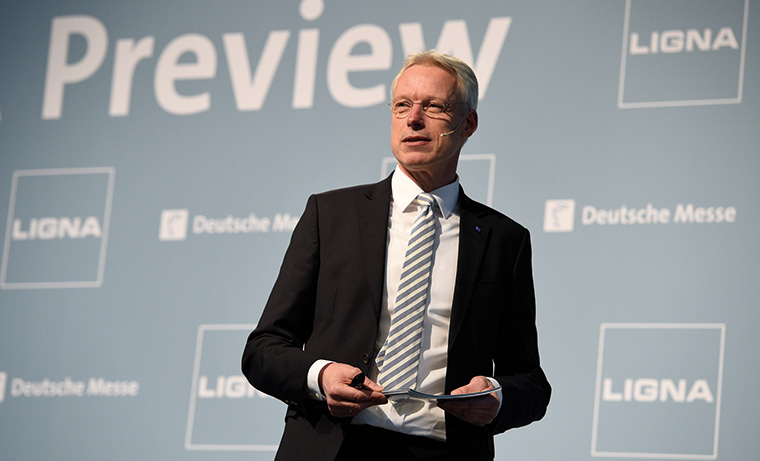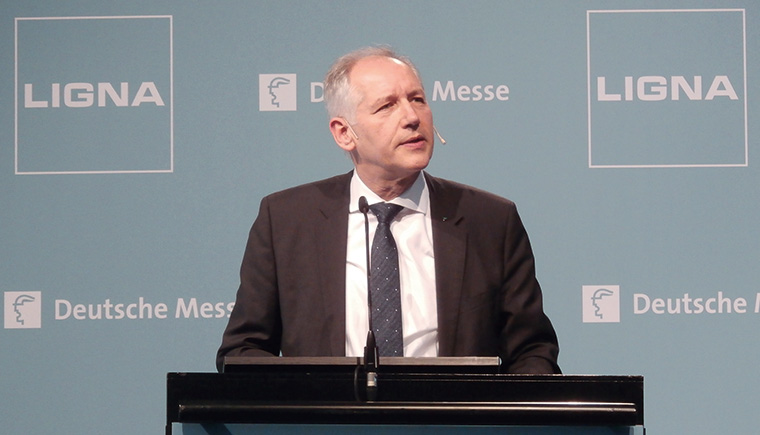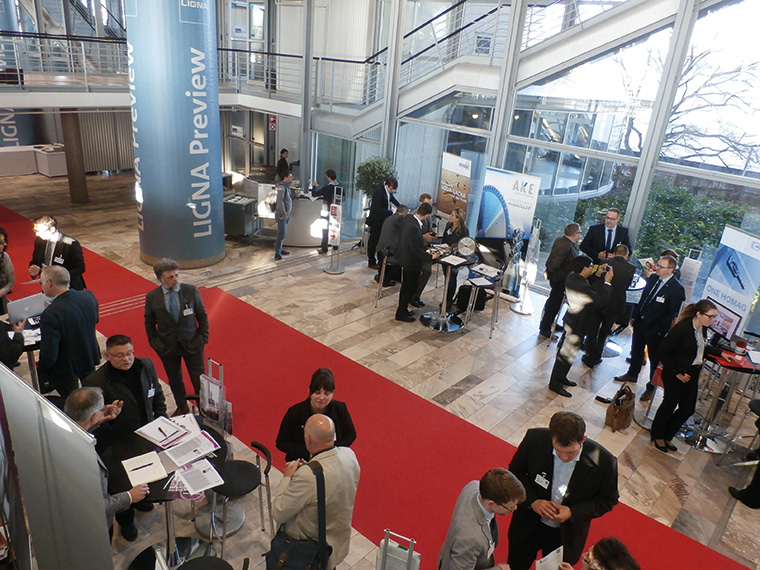The world’s biggest woodworking machinery fair nears. With organisers Deutsche Messe and the German Woodworking Machinery Manufacturers’ Association (VDMA) predicting favourable economic conditions, this year’s Ligna – taking place from 22nd-26th May at the vast Hannover showgrounds in Germany – is primed for success.
Set to feature more than 1500 exhibitors from 45 countries, Ligna is a truly international platform. While roughly half of the expected (net) 122,000m2 exhibition space will be occupied by German suppliers, Italians account for a further 25%, and Austrians for 10% – while exhibitors from Turkey, Denmark, Sweden, China, The Netherlands and Switzerland comprise the bulk of the remainder.
Ligna’s appeal is undeniably international, too. The last edition, in 2015, attracted some 93,000 visitors – and the organisers are expecting trade visitors from around 90 nations to this year’s, which, bolstered by a stronger thematic layout (see boxout), promises even greater opportunities to find and conduct business.
The five-day presentation will take place across 10 halls of Hanover’s Deutsche Messe, plus its open-air site. From mass-production technology and wood-based panel production solutions, to new areas covering surface technology, machine components and automation, the product spread is comprehensive, and easier to navigate than ever, promising visitors the chance to specify more successfully solutions in today’s ‘Industry 4.0’ world.

Dr Andreas Gruchow
“The new approach and, more importantly, the new physical layout, have been extremely well received,” commented Dr Andreas Gruchow, the Deutsche Messe managing board member responsible for Ligna, at the outset of the preview’s press conference.
“This year, the exhibitors are presenting a wide array of innovations for intelligent, networked manufacturing systems, not to mention new ideas and strategies for the many value creation networks at play in the wood processing and woodworking industries.”
Alongside these exhibitors will be numerous special features designed to engage, educate and challenge visitors.
These include an array of displays themed around Integrated Manufacturing, a Processing of Plastics and Composites review, a series of training courses, and the Wood Industry Summit, which will present solutions for timber harvesting and primary processing, and advanced technologies for integrating the processing steps involved. There is also the RFID Factory activity zone, which aims to demonstrate the implementation of digital integration in the wood and furniture industries.
The conference was opened by Ligna spokesperson Anja Brokjans, who welcomed the many journalists and exhibitor representatives in attendance.
She posed the question: “What does the factory of the future look like?” She then went on to summarise the wealth of technological advances visitors will encounter, and how the potential for greater efficiency is increasing year by year.
The preview then saw Andreas take to the stage to outline Ligna’s unique strengths. “None of the other shows that take place here are as prominent in their industry as Ligna,” he stated. Andreas expressed his gratitude to the sector’s leaders for their help in facilitating the new layout – the industry’s giants are distributed evenly across the show.
Andreas then explained how the demand for lot-size-one solutions, greater price-to-performance ratios and intelligent systems will be addressed by Ligna’s exhibitors.
Next, Wolfgang Pöschl, president of the VDMA’s Woodworking Machinery Association and CEO of machinery manufacturer Michael Weinig, revealed a positive outlook for the German woodworking industry, calling it “a good prerequisite for Ligna”.

Wolfgang Pöschl
He noted that one of the key drivers of growth in the sector is digitalisation, which is enabling businesses of all sizes to meet demand for flexibility and individualisation in terms of a product’s dimension and design.
Finally, Giulio Masotti, CEO of design project solution Wood-Skin and Mammafotogramma Studio, presented a treatise on the innovations that inspire his work, and promised the potential to depart from the traditional forms and shapes of mass-market furniture.

The journalists then took to the exhibition floor to meet representatives from around 30 of the fair’s exhibitors, including software providers 20-20 Technologies and imos, machinery specialists Biesse, SCM, HOMAG, Felder, Weima and Michael Weining, and tooling expert Leitz.
Many took advantage of the opportunity to reveal their latest developments. Biesse, for example, promises over 40 solutions, targeting manufacturers large and small, as well as solutions for the wood construction sector, advanced materials, and improved customer care through Biesse Services. In collaboration with Accenture and Microsoft, the company will also present a cloud-linked Rover machining centre.
Software specialist imos – which works through in3D Software in the UK – presented its new joined-up design, manufacture, costing and PoS package, which culminates in Augmented Reality (AR) and Virtual Reality (VR) applications that promise to put a virtual furniture design into customers’ homes. Although modular in nature, the software’s clear presentation and intuitive controls make it an exciting prospect for manufacturers and retailers alike.
Soon after opening its new branch office in Berlin-Velten in late March, the Felder Group will present several new machines at Ligna, including a five-axis CNC machining centre, an edgebander and panel saws, plus its newest brushing machine, multi-borer, compact beam saw, materials handling system and more.
In all, the press preview reaffirmed Ligna’s vision and comprehensive offer – it is, indeed, the woodworking industry’s essential international fixture, and it has been working hard to refine its upcoming edition.
“The business climate in the wood industry is positive, offering a wealth of market opportunities,” concludes Andreas. “Ligna captures those opportunities perfectly.”









